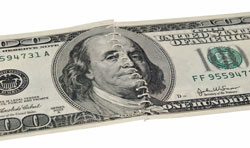 2. The word “bankrupt” is from the Italian banca rotta, literally “broken bench.” In the years of early banking, people who exchanged, stored, and lent money did their business in the public marketplace at a bench. If the man at the bench, or the “banker,” ran out of money or was unfair, his bench would be broken. (Source: http://bankassoc-kos.com/en/10-facts-about-money-and-banks)
2. The word “bankrupt” is from the Italian banca rotta, literally “broken bench.” In the years of early banking, people who exchanged, stored, and lent money did their business in the public marketplace at a bench. If the man at the bench, or the “banker,” ran out of money or was unfair, his bench would be broken. (Source: http://bankassoc-kos.com/en/10-facts-about-money-and-banks)
 3. In the mid-1990s in Japan, a company called Hitachi introduced an ATM that would sterilize bank notes. According to Forbes, this was done by heating them to 392 degrees. Although a novel idea, the notes are re-contaminated as soon as they are touched by human hands. (Source: http://www.medicaldaily.com/dirty-money-cash-obviously-teeming-bacteria-anything-being-done-clean-it-278400)
3. In the mid-1990s in Japan, a company called Hitachi introduced an ATM that would sterilize bank notes. According to Forbes, this was done by heating them to 392 degrees. Although a novel idea, the notes are re-contaminated as soon as they are touched by human hands. (Source: http://www.medicaldaily.com/dirty-money-cash-obviously-teeming-bacteria-anything-being-done-clean-it-278400)
 4. It took the city of Montreal 30 years to pay off its Olympic debt of $2 billion, held in 1976. (source: www.delraycc.com/interestingmoney/12-amazing-facts-about-credit-card-debt)
4. It took the city of Montreal 30 years to pay off its Olympic debt of $2 billion, held in 1976. (source: www.delraycc.com/interestingmoney/12-amazing-facts-about-credit-card-debt)
 5. U.S. paper money is not paper. It's cloth. In Ben Franklin’s day, people repaired torn bills with a needle and thread. (source: www.mentalfloss.com)
5. U.S. paper money is not paper. It's cloth. In Ben Franklin’s day, people repaired torn bills with a needle and thread. (source: www.mentalfloss.com)
 6. Government of India's first set of notes was the Victoria portrait series. For security reasons, the notes of this series were cut in half; one half was sent by post, and upon confirmation of receipt, the other half was sent. (source: www.indiatoday.intoday.in/education/story/indian-currency-ten-lesser-known-facts/1/433586.html)
6. Government of India's first set of notes was the Victoria portrait series. For security reasons, the notes of this series were cut in half; one half was sent by post, and upon confirmation of receipt, the other half was sent. (source: www.indiatoday.intoday.in/education/story/indian-currency-ten-lesser-known-facts/1/433586.html)
Chosen by: Beata Lewicka






